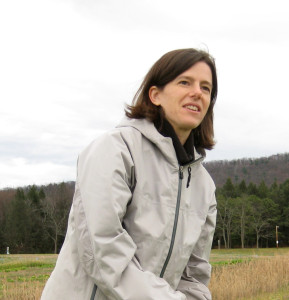 Farmers want to maximize the land where they cultivate their crops.
Farmers want to maximize the land where they cultivate their crops.
But, Meagan Schipanski‘s research indicates: it might be beneficial to alternate planting cash crops with cover crops.
Dr. Meagan Schipanski is an assistant professor of agroecology in the Department of Soil and Crop Sciences at Colorado State University. Her research focuses on soil biogeochemistry and plant diversity in cropping systems. She earned her PhD in 2009 from Cornell University.
Co-authors: Mary Barbercheck | Margaret Douglas | Denise Finney | Kristin Haider | Jason Kaye | Armen Kemanian | David Mortenson | Matthew Ryan | John Tooker | Charles WhiteMeagan Schipanski – Cover Crops vs. Cash Crops
More than 40% of the Earth’s land area is used for agriculture. How we manage this land has huge implications for food availability today and tomorrow and for our air and water quality. Agricultural success is typically measured by yields and short-term profitability. However, as we continue to demand more from our agricultural lands, we need new approaches for evaluating success.
As a multi-disciplinary group of researchers at Penn State University, we saw the potential for agricultural systems to provide a broader suite of ecosystem benefits or services. We developed a framework for evaluating different management systems based on more than 10 ecosystem services. We focused on cover crops, which are plants grown between harvested crops to literally ‘cover’ the soil, because we have long known that planting cover crops can reduce soil erosion and nutrient leaching, yet their adoption has been limited. We wanted to ask what other benefits do cover crops provide and what are the management trade-offs that limit their adoption?
Our research highlighted that cover crops influence a wide array of ecosystem services, including increased soil nitrogen and beneficial insect conservation, and more mycorrhizal colonization, which are a beneficial soil fungus that helps plants absorb nutrients.
We also showed that commonly used measurements of ecosystem services can be misleading due to the episodic nature of some services. For example, nutrient-retention benefits occurred primarily during spring and fall, weed-suppression benefits occurred during the summer, and soil-carbon benefits accrued slowly over decades.
As we continue to live in an increasingly interconnected world, we need research and management approaches that embrace complexity. We hope that our approach will inspire more collaborative efforts that move us toward the development of more sustainable agricultural systems.
Read More: A framework for evaluating ecosystem services provided by cover crops in agroecosystems

Comments
One response to “Meagan Schipanski – Colorado State University – Cover Crops vs. Cash Crops”
How to get PDF Professor (Horticulture) specialization in Vegetable production, vegetable physiology and Post-harvest technology of Fruits and Vegetables?